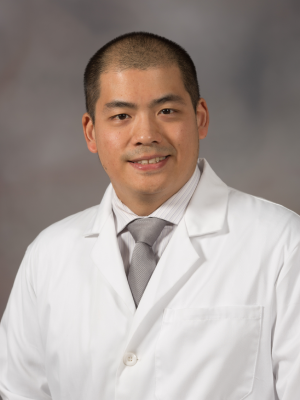How to keep macular degeneration from affecting your focus
It’s the most common cause of progressive, severe vision loss in individuals above age 50. By the time someone notices symptoms of the disease, it may be too late for an eye care professional to do much about it. Left untreated, it can completely rob someone of his or her central vision.
Little wonder, then, that the American Academy of Ophthalmology has dedicated the month of February to advancing awareness of age-related macular degeneration, or AMD.
Experts aren’t quite sure of the exact causes of the disease that attacks the macula, the central, most sensitive part of the retina, but an estimated eight million people are in the early stages of AMD in the U.S. alone.
The good news is that vision specialists at the University of Mississippi Medical Center understand what behaviors can reduce its risks and even lessen its impact.

AMD can affect anyone, but Dr. Brian Tieu, UMMC assistant professor of ophthalmology, said it is more common among Caucasians and slightly more prevalent among females.
“Although we don’t know for sure what actually causes it, there are genetic and environmental risk factors, such as smoking, eating an unhealthy diet and cardiovascular disease,” said Tieu, who along with Dr. Albert L. Lin, UMMC assistant professor of ophthalmology, are retina specialists who diagnose and treat AMD regularly. “The most common symptom is loss or distortion of central vision: Patients will have more difficulty seeing someone’s face or anything centrally, but their peripheral vision will be stable.”
To understand how the condition attacks the macula, Lin likens retina cells to tiny factories that make the tools and products necessary for vision.

“The most common hypothesis scientists and ophthalmologists have come up with about AMD is that the condition represents a long-term deterioration of the macula via accumulation of by-products from cell production,” Lin said. “Like all factories, there’s a ton of garbage materials that are created as by-products to keep the factories running.
“There’s no way for the factories to transport these by-products out of the eye, so they’re left sitting around. Over time, the waste by-products accumulate and break down - kind of like oil or radioactive waste - and the breakdown then causes damage to the factory’s surroundings.”
An important distinction among sufferers is termed “dry” AMD and “wet” AMD. In its dry form, AMD is slow and progressive, while in its wet form, the onset is often rapid and quickly noticeable.
“Many patients with dry AMD will not have vision issues, and its only noted during a routine eye exam,” he said. “Later during the course of the disease, slight central vision blurriness or distortion may be noted. If you look at a straight line, people may notice the line is wavy and dips up and down.
“The degree of distortion wet AMD patients experience is severe, and they may also notice a dark or blind spot in their central vision. This occurs because in some patients, a blood vessel breaks through the retina and begins to leak blood and fluid. This leakage, in turn, damages the retina and distorts vision and, if the leakage is not addressed quickly, permanent damage may result.”
While everyone who suffers from age-related macular degeneration has the dry form, Tieu said only 10 to 20 percent of patients progress to wet AMD. While those in the early stages of dry AMD may have normal vision for years or even decades, once the disease gets advanced enough, non-reversible vision changes or vision loss may begin to occur.
So how can AMD be treated effectively?
According to Lin, a National Institutes of Health study found a combination of vitamins halted the progression of dry AMD in 25 percent of patients. That “cocktail” of Vitamin C, Vitamin E, beta-carotene, zinc and copper has been adjusted a bit, but it remains “the only thing we have evidence for that slows down the progression,” he said.
Tieu recommends over-the-counter “eye” vitamins called AREDS II that have been shown to help decrease progression of intermediate dry AMD to advanced AMD.
“Patients should have an evaluation of their AMD by an ophthalmologist prior to starting to see if these will benefit,” Tieu said.
Treatment options for wet AMD have progressed during the last 30 years, Lin said.
“Management of the condition has been revolutionized by a class of medications called anti-VEGFs,” he said. Administered as an injection into the eye, “these medications work by shrinking the blood vessels responsible for vision loss and helps improve vision.
“Now, it is not unheard of for patients to regain most or all of their vision back after treatment.”
So how can someone reduce his or her risk of developing AMD? First and foremost on the list: Quit smoking, or never start the habit in the first place.
“If there is only one thing I can ask people to do to reduce their risk of developing AMD, it is to stop smoking,” Lin said. “Like all other diseases, smoking makes AMD worse and makes it progress faster.
“The patients that I see with the worst AMD at an earlier age are all smokers, have smoked in the past or have been exposed to second-hand smoke for a long time.”
Tieu also recommends eating a healthy diet (including lots of green, leafy vegetables and low in saturated fat), exercising frequently and keeping heart disease, high blood pressure and cholesterol levels in check.
“Wearing sunglasses outside may be beneficial as well,” he said. “A dilated eye exam, at least yearly, is recommended to detect or monitor any age-related changes in the retina.”
Because early detection is so vital to properly addressing the damage AMD can cause, Tieu said it is imperative that individuals consult an ophthalmologist regularly.
“Ophthalmologists, especially retina specialists, can diagnose AMD and distinguish it from other eye diseases that may cause similar symptoms,” Tieu said. “We can also monitor, manage and treat this condition.
“AMD can affect anyone over time, so it’s important for people to pay attention to any change in their vision and get evaluated by an ophthalmologist as soon as they can. Good surveillance with early detection and treatment of AMD can help patients maintain good vision for a long time.”
Lin said a screening exam can help detect AMD or other conditions that could cause vision issues down the road.
“This is one of the most common conditions retina specialists treat,” he said, “and we keep up with all of the latest updates in clinical care and management.”
To schedule a vision exam or consultations with a UMMC ophthalmologist, call (601) 984-5020 or visit /Healthcare/Eyes%20and%20Vision/Eye_Vision_Ophthalmology_Home.html.
The above article appears in CONSULT, UMMC’s monthly e-newsletter sharing news about cutting-edge clinical and health science education advances and innovative biomedical research at the Medical Center and giving you tips and suggestions on how you and the people you love can live a healthier life. Click here and enter your email address to receive CONSULT free of charge. You may cancel at any time.



